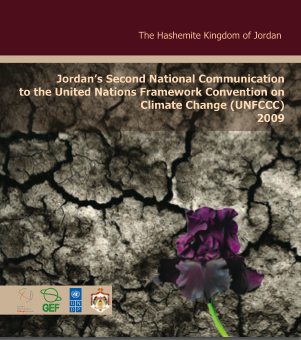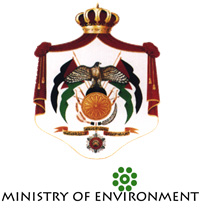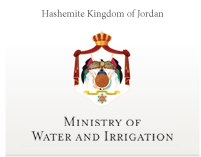Jordan's Second National Communication - 2009
Project Overview
The creation of a National Communication offers countries the opportunity to contribute with technically sound studies and information that can be used for designing mitigation and adaptation measures, and project proposals that can and will help increase their resilience to the impacts of climate change. Activities generally include: V&A assessments, Greenhouse Gas Inventory preparation, Mitigation Analysis or Education, and awareness raising activities.The ultimate goal is the integration of climate change considerations into relevant social, economic and environmental policies and actions.
In the longer term, Jordan is likely to face severe water shortages, a problem that can be overcome only through increased regional co-operation. Jordan’s most pressing environmental problems are the need to manage more effectively the scarce water resources and cultivable land in order to meet the populations growing needs.
Key Vulnerabilities:
- Agriculture
- Water Resources
- Public Health
Project Details
The Hashemite Kingdom of Jordan stretches over an area of over 90,000 square kilometers in the hot and dry region of West Asia. It is an almost land-locked country, bordered by Israel and the West Bank to the west, Syria to the north, Iraq to the east and Saudi Arabia to the southeast. The port of Aqaba in the far south gives Jordan a narrow outlet to the Red Sea. Jordan’s outstanding topographical feature is the great north-south rift, stretching from Lake Tiberias through the Jordan River Valley to the Dead Sea (the lowest point on earth, more than 400 meters below sea level). Jordan has three major rivers: Jordan River and its two principal tributaries, the Yarmouk and the Zarqa rivers. Because of its salinity and other quality problems, surface water is used mainly for irrigation. Drinking water is taken from underground aquifers and King Abdullah Canal.
Jordan has a population of 6.5 million (CIA World Factbook 2012). Over 40 per cent of Jordan’s population resides in the Amman area. In the longer term, Jordan is likely to face severe water shortages, a problem that can be overcome only through increased regional co-operation. Jordan’s most pressing environmental problems are the need to manage more effectively the scarce water resources and cultivable land in order to meet the populations growing needs.
More than 80% of the country is made up of unpopulated desert. Water resources in Jordan depend chiefly on precipitations within the country; exceptions are the Yarmouk River, which is fed mainly by the rain that falls on Syrian territory, and the Azraq aquifer, whose replenishment also depends on precipitations in Syria. The annual average rainfall ranges between 600mm in the northern uplands and less than 50mm in the southern and eastern desert areas. It usually rains between October and May, with heavier precipitations between December and March, when 80% of the annual rain falls.
Potential Adaptation Measures
Agriculture
- Main adaptation measures at farm level included conservation agriculture, improvement of water use efficiency, implementation of water harvesting techniques, supplemental irrigation with treated wastewater and community-based management of rangeland resources.
- Policy and legislation options, capacity building for mitigation and adaptation assessment and monitoring of vulnerability, early warning and risk management systems, knowledge management and technology transfer, and rehabilitation of livestock systems and rural livelihoods.
Water Resources
- Water conservation
- Finding additional water sources (desalination and wastewater reuse)
- Water demand management
Health
- Strengthening surveillance and establishment of highly sensitive alert system by the development of health forecast system for climate sensitive diseases.
- Prevention and control of emerging and re-emerging vector- borne diseases.
- Strengthening the existing emergency preparedness and disaster management
- Improving data collection on diseases related to climate change and establishing database for the collected data.
Key Results and Outputs
- Sustainable development and the integration of climate change concerns into medium and long term planning
- Inventories of anthropogenic emissions by sources and removals by sinks of greenhouse gases
- Measures contributing to addressing climate change
- Research and systematic observation
- Climate change impacts, adaptation measures and response strategies
- Education, training and public awareness
Reports and Publications
Assessments and Background Documents
Jordan's Second National Communication Official Document - 2009
Monitoring and Evaluation
In 1992, countries joined an international treaty, the United Nations Framework Convention on Climate Change, to cooperatively consider what they could do to limit average global temperature increases and the resulting climate change, and to cope with whatever impacts were, by then, inevitable.
Parties to the Convention must submit national reports on implementation of the Convention to the Conference of the Parties (COP). The required contents of national communications and the timetable for their submission are different for Annex I and non-Annex I Parties. This is in accordance with the principle of "common but differentiated responsibilities" enshrined in the Convention.
The core elements of the national communications for both Annex I and non-Annex I Parties are information on emissions and removals of greenhouse gases (GHGs) and details of the activities a Party has undertaken to implement the Convention. National communications usually contain information on national circumstances, vulnerability assessment, financial resources and transfer of technology, and education, training and public awareness.
Since 1994, governments have invested significant time and resources in the preparation, collection and validation of data on GHG emissions, and the COP has made determined efforts to improve the quality and consistency of the data, which are ensured by established guidelines for reporting. Non-Annex I Parties receive financial and technical assistance in preparing their national communications, facilitated by the UNFCCC secretariat.





